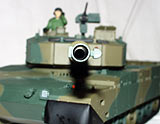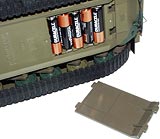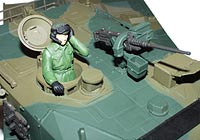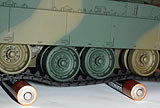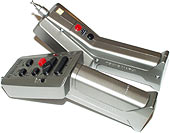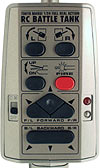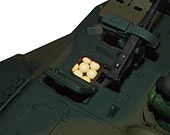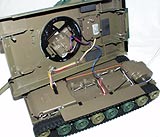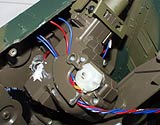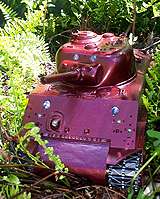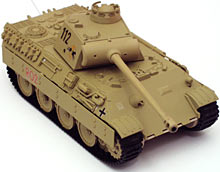
Tokyo Marui radio controlled JGSDF Type 90 tank
Review date: 3 December 2000.Last modified 03-Dec-2011.
In case you've been wondering, this...
...is what fun looks like.
Tokyo Marui's 1/24th scale radio controlled Japanese Ground Self-Defense Forces Type 90 Main Battle Tank is, ladies and gentlemen, The Business.
At a glance, it doesn't look terribly exciting.
It's not very large - the chassis has a footprint of about 30 by 14.5 centimetres (13 by 5.75 inches), not counting the gun. It's got rubber tracks and plastic wheels and really isn't capable of driving over anything much more challenging than carpet. It doesn't have proper proportional speed or steering control. One mile an hour is about as fast as it gets. And it's considerably more expensive than various other rubber-track toy-tanks.
But it shoots. And it shoots hard.
What it shoots are six millimetre plastic balls. This, plus the manufacturer, will have tipped off those who appreciate fine and somewhat dangerous toys to the fact that this tank is actually part of the Airsoft line.
Of which more in a moment.
What you get
The tank comes complete with radio transmitter, a (far too) small bag of ammo, all-Japanese instructions, and various decorative extras like the chap who sticks out of the hatch and the multi-part machine gun for the lid.
There's a space in the box for the eight AA cells and one 9V battery you need to get the Type 90 running (the AAs go in the tank, the 9V goes in the transmitter), but no batteries were provided with the tanks I got.
The tank's battery bay's on the bottom; another three cells sit under the five you can see.
There's lots of detail, and everything is sharply moulded and good looking enough that you could use the tank as a display model when you're not out plinking.
Many rubber-track cheapie-tanks are quite poorly made, and don't actually look much like whatever they're supposed to be - they have major problems like turrets the wrong shape, the wrong number of road wheels, that sort of thing. I'm no world authority on what a real Type 90 looks like, but the Marui one certainly seems to match what photos I could find.
It's not up there for detail with Tamiya's 1/35th scale static models, but for a buy-and-go R/C kit it's really excellent. I was surprised.
The collection of plug-in extra bits helps. Along with the hatch-soldier (who's optional - you can leave him out and just leave the hatch closed) and the four-part machine gun, you get antennas, lights, tow hooks, a rope to hang on the back, that sort of thing. All of the little bits come on the usual plastic model kit frames of moulding sprue. You clip them off the sprue with side cutters.
Most of the extra bits are a perfectly all right friction fit in their mounting holes; a couple need a drop of glue. You don't need to add them at all if you don't want to, of course.
Parts that plug into bits of the tank that are plain olive green plastic are plain olive green; parts that plug into bits of the tank with the darker green camouflage mottling paint on them are pre-painted to match. Nice.
The painted parts are a bit of a tight fit in their holes; have no fear, as Marui provide you with a metal prong with which to ream the holes out a bit!
The road wheels have realistic swing-arm suspension, but there isn't enough give in the rubber track for it to make a huge amount of difference. Looks cool, though.
The radio is a quite comfortable pseudo-pistol-grip unit that takes a single nine volt battery, and lets you steer the tank, rotate the turret and change gun elevation. And shoot. There are two fire buttons, and you have to hold them both at once to actually shoot.
There's a "boost" button in the trigger-finger location on the controller, that gives you more speed in straight-forward mode. You can do the same thing by hitting the back-right button while driving forward, so you don't actually have to fish about on the bottom of the controller for the boost - you can leave your trigger finger on the second fire button, where it belongs!
All of the buttons except for the boost and second fire controls are on the top of the radio. There's no wheel or stick, and no proportional control - every button is all or nothing. But for a slow tank that's not a big deal.
The tank's turret can traverse almost a complete 360 degrees - it can't face straight backwards, though, and its drive system will just make an unhappy clicking sound if you try to exceed the limit.
You can raise and lower the gun, but there's only one button to do it with - hold that button and the gun gently swings up, then down, then up, then down...
You load the tank with BBs through this hatch in the top. You can pour in more than 40 rounds.
The main on/off switch is on the bottom of the tank, but there's a separate switch, under the loading hatch, that turns the gun mechanism on and off. You can render the gun harmless by shaking all of the ammo out of the tank, of course, but cycling the firing mechanism with nothing loaded is bad for it. So being able to completely disarm the tank when you hand the controller over to someone you don't trust to leave the red buttons alone is nice.
You get one of these red rubber barrel plugs with the tank, as well; the gun doesn't have enough power to dislodge it, and it makes the thing obviously safe so you don't feel nervous about looking at it.
Shootin'!
When you've loaded some ammo and you hold down both fire buttons with the firing switch turned on, the firing motor buzzes and a red LED on the front of the turret goes on to warn you that the shooting mechanism is winding up. Then the tank goes ka-POP.
And then there's a series of tick-tick-tick noises as the shot bounces around your house.
And then you say "Jesus H. Christ!"
Well, that's how it worked for me, anyway.
Marui are not whistling Dixie when they tell you to wear eye protection; ricochets are dangerous. And they are not exaggerating when they say the tank has 25 metre range - aim high and you can probably shoot quite a bit further.
Hold the fire buttons down and the mechanism cycles. The rate of fire is a bit less than one round per second - I counted ten rounds in 11.5 seconds.
The little plastic BBs may only weigh 0.12 grams, but they fly fast enough that you will not see them leave the gun barrel. Peer past the tank and you can clearly see the BB fly, but looking at it from the side you've got no chance.
The balls don't carry much energy - hang a plastic sandwich bag over the gun and it'll only be shot off about six inches - but the pellets are nonetheless perfectly capable of hurting someone.
Getting shot in the eye by one of these things might not blind you permanently, particularly if you weren't staring right down the barrel when it happened. But you would not enjoy it.
I got an amount of spare ammo with the tanks which could fairly be described as One Quantity. The BBs are very cheap.
If you can find BBs you've fired (which is a fairly large "if"), you can re-use them, as long as they're clean and undamaged. Competition Airsoft players never re-use BBs, because they may have scratches or chips or other deformations that'll damage the seals in their guns.
What guns, you ask? Quite serious guns, actually.
Airsoft
As far as I know, the Type 90's the only Airsoft product that isn't a handgun or rifle. Tokyo Marui, and a few other manufacturers, make accurately modelled Airsoft replicas of pretty much every popular firearm in the world, not to mention various special custom guns and sci-fi weapons. A catalogue comes with the tank, and features exceedingly butch hardware from cover to cover.
The cheapest electric Airsoft guns are cartoonish "minis", scaled down $US30 comic-book guns made to vomit pellets as frequently as possible in the general direction of the target. This sort of thing:

But the rest of the Airsoft range often look just like the originals. Some feel pretty much like them, too, though they're usually considerably lighter. They're even used for training by some military and police groups.
Accordingly, various countries classify them under some combination of their air-gun and replica-firearm laws, and here in Australia you need a gun license to own one. The same might also, technically, apply to the "mini" guns, but nobody's likely to be able to rob a bank with one of those.
Real Airsoft guns come with a plethora of stern safety warnings, not least of which is that playing games with the full scale guns should be done out of sight of the public, lest someone see a load of maniacs with assault rifles, apparently very happy about the murders they're about to commit, and call out guys in uniforms with no sense of humour, who'll very professionally show the alarmed Airsofters some genuine people-killing guns.
Firepower
Airsoft guns lie right on the line between "toy" and "weapon". The Type 90 is a low powered Airsoft, but it's still not a kid's toy. I shot at some pieces of ordinary 80gsm copy paper, and the tank had no trouble punching holes in it at ranges up to four metres (13 feet). Firmly support the paper on all sides, so it can't flap when it's hit, and it's easier to puncture at greater ranges.
By way of a manly experiment, I shot myself in the sole of the foot, at short range.
It stung like a bastard. Despite the tank probably having only about 0.1 joules of energy per shot, or less. It didn't leave a bruise.
I would have been less keen to try that trick with any of the higher powered Airsoft weapons.
The high-rate-of-fire Airsoft Minis have about 0.2 joule projectile energy, tops; actually, 0.1 seems more likely. Joules, for the physics-impaired, equal watts times seconds. Run a 100 watt light bulb for one second and it's emitted 100 joules of energy.
Gas powered Airsoft pistols, charged from a spraycan or equipped with a paintball-style pressure fitting, generally manage about 0.4 joules, or maybe more for the ones with a fitting that you can run from very high pressure air. Most of the bigger Airsoft guns still manage less than 1 joule. Apply various options to the bigger single-shot rifles and you can make them into a gas powered five joule weapon. But you'll be paying a few hundred American dollars for the privilege.
For comparison, quality air rifles can commonly manage 25 to 35 joules. The airguns used to knock down yellow tin ducks in a sideshow probably do about 10 joules. A paintball gun firing at the international speed limit of 300 feet per second muzzle velocity has an energy of about 17 joules.
All of this is chickenfeed compared with real firearms, of course. A humble .22 Long Rifle cartridge is good for about 190 joules, Harry Callahan's .44 magnum's maybe 1320 joules, a 7.62mm NATO cartridge is 3320 or so - about the same as a 12 gauge shotgun shell. And in order to impart the same energy to a target as a single .50 BMG round can carry out of the barrel, you'd apparently have to fire more than 150,000 6mm BBs out of your Marui Mini MP5.
For further firearm geekery, knock yourself out on the table and links here.
The 0.12 gram BBs used by the Type 90 are the lightest Airsoft ammunition that exists - most Airsofters fire 0.2 gram, or heavier, ammo.
Lighter projectiles fly faster, but also slow down faster because of air resistance, which increases with the square of the speed. Heavier BBs have a lower muzzle velocity but hold their energy better, because they're not being so mean to the air molecules they encounter. They're blown off course by the wind less, as well.
I don't know whether firing heavier ammunition in the Type 90 would hurt it, but it wouldn't surprise me if it did, eventually. You'd get better range and maybe a bit more accuracy. But if you're shooting for relatively small targets, like for example a piece of Styrofoam lightly attached to the top of another tank, you've really got close to no chance of hitting it at longer than indoor ranges no matter what ammo you use.
There's a cardboard target included with the tank, by the way, but printing a target on a piece of paper is better - the tank can knock holes in that, which is far more satisfying than putting a little dent in some cardboard.
Driving
Driving around, the Marui tank's not very impressive.
Its rubber tracks, like all rubber tracks, eat a lot of its meagre motor power, and the lack of proportional control means you have to do fine lateral gun aiming with the turret traverse. Which, by the way, you can do while driving - the radio system can handle multiple commands at once.
If you press two steering buttons at once (one forward right, one backward left, say) you can pirouette in place, driving one track forward and one track backward. Normal steering just locks one track and drives another.
You can't really drive the Type 90 anywhere but on a flat, clean surface. Rubber-track tanks never have a lot of power, and this one's no exception; it'll bog completely on grass of any real length, and a leaf is enough to jam a track. It can climb an incline, but not a terribly steep one. It's an indoor toy, folks.
The tank only does about 1 kilometre per hour in normal mode, or about twice that, straight forward only, with the Boost button pressed.
Inside
You only need to remove four screws (one inside the battery compartment) to get the lid off the Type 90...
...but there's not a lot to see, immediately, when you do. Motor assembly at the back (containing two weeny little blink-and-you'll-miss-'em brush motors), electronics box at the front, hole in the middle for the turret assembly to stick down into. You can see the black turret rotation ring gear.
The main electronics board is of better quality than many Chinese "hang it on the wall and throw solder at it" fabrications.
A few more screws removed, and the turret's off and open.
The gun elevation mechanism's at the back of the turret. It's just another titchy motor, geared down and turning this large gear with a profile-cut cylinder hanging from it. A tab on the back of the gun assembly acts like a cam follower on the cylinder. The large spring visible in the foreground pushes the gun back downwards (or upwards as you look at it here, with the turret upside down) and keeps the tab pressed against the elevator.
This is the firing mechanism itself, but I couldn't get it apart without unsoldering all of the short wires that tether it to the rest of the tank, and I just didn't have the energy. Especially when I had visions of my efforts resulting in a spring pinging off into an invisible corner of the room.
The operation of the mechanism's simple enough. The BB to be fired rests on an O-ring in front of the cylinder, and the motor drives a partially toothed gear wheel which engages a toothed rack, which is connected to a spring, which isn't actually the firing spring; a kind reader's actually fully stripped his Marui tank's firing mechanism, and found the real firing spring inside the piston. The one you can see is just a return spring.
Anyway, when the toothed part of the wheel turns past the rack and disengages, there's nothing to stop the firing spring from popping back and pushing the piston with it, and one 6mm BB is on its way downrange.
There's some more rubber in there, too, that's called a "hop-up" mechanism - it puts some backspin on the ball to keep its trajectory up. You can see the effect if you're doing long range shooting - the ball flies pretty much straight, then curves distinctly upwards before falling. The upwards trajectory, by the way, makes it remarkably difficult for one tank to actually shoot the other, if they're both on a level surface. It's better to stick a target-object on top of the other tank.
The motor-and-piston shooting system doesn't fire the second you hit the fire buttons, unless you've wound it up with little dabs on the buttons beforehand so it's right on the edge of releasing already. There's a quiet click that tells you where that point is.
On the plus side, though, the fact that the spring provides the firing impetus means that the tank shoots just as powerfully when the batteries are almost flat as it does when they're new. Less battery power just means a lower rate of fire; you can keep shooting, and the spring has just as much energy, until there's not enough juice to pull the spring back any more. Or, more realistically, to run the receiver hardware while the spring motor's pulling.
This is the firing spring. It could easily be replaced with a stronger one, which would give you more energy per shot but a lower rate of fire, as the motor laboured to pull back the stronger spring. Stronger springs also put more strain on the firing gearbox.
If you want to see many pictures of the innards of a "proper" Airsoft gun, being upgraded to do unto others more effectively, look here - all of the links are to pictures.
Where to get it
You probably won't find a Type 90 in your local hobby store - at least not here in Australia. Nobody's likely to care if you own one - if you shoot someone's eye out, that's your problem - but anyone who decided to sell them could be liable in large and unpleasant ways.
I bought my Type 90s from HobbyLink Japan, a place where anybody who appreciates the various hobby products that are easy to find in Japan but can be hard to get anywhere else can spend all of their money at great speed.
Hobbylink Japan is unusual. Most Japanese hobby stores, and hobby products companies for that matter, seem to believe there are two kinds of customers:
1) Japanese customers, and
2) Customers who can go and take a long walk off a short pier.
The Web sites, if they even have one, are often in nothing but Japanese, outside-Japan orders are impossible, and if you send e-mail asking about stockists in your country, they never reply. OK, maybe that's because nobody there can read English, but that can't be true all the time.
Hobbylink Japan exists purely to sell the stuff that overseas buyers want to get from the uncommunicative dealers. Mainly static models - you want giant robot kits, they got 'em - but some radio control gear as well.
Scott T. Hards, President of HobbyLink Japan (e-mail scott@hlj.com), was good enough to make sure I got one tank on each frequency. As with many cheapo R/C toys, there's just "a 27MHz one" and "a 40MHz one", and you can't change frequency crystals to use more than two tanks at once.
The tank itself is 14,800 yen from HLJ - $US134 or $AU249, at time of writing. HLJ provide a handy link to the Universal Currency Converter on their product pages, so you can figure out what that means in your currency.
A bag of 1800 rounds of ammunition is a mere 300 yen - five bucks Australian, $US2.70.
Even a single Type 90 comes in a good-sized box, though, so air shipping will cost you a hefty amount more.
Landed in Australia, you're talking about $AU720 ($US385) for a pair of tanks and ten 1800 round bags of ammo. If, that is, your shipment breezes past the nice chaps at Customs who might otherwise elect to hold it until you shell out for import duty. Mine did. Nyaah.
Shipping accounts for about $AU175 ($US94) of the total, thanks to the bigness of the box; I don't know what you'll pay for shipping to the USA or other parts of the world, and shipping for one tank is apt to be more than half of shipping for two.
But even if you're dropping, say, $AU400 ($US215) for a single tank, you're still not paying a fortune by hobby standards. Tamiya's 1/25th scale R/C Panther tank is $US200 (if you can find one - Tamiya do limited production runs, apparently out of spite), but it needs a transmitter that doesn't come with it. It's got more power than the Marui tank, and proper articulated tracks, but it's still not a proper off-roader. And the turret doesn't even move, much less shoot.
Tamiya's all-singing all-dancing 1/16th scale Tiger 1, which has articulated tracks and sound effects and muzzle flash and, really, everything but a gun that actually fires, is $US700 without radio and battery packs. It's selling for $AU1500 here.
Now, the Tiger's a much more capable tank, driving-wise, than the Marui, but it's still not really meant for bush bashing. If you want a tank with truly tank-like durability, you've got to drop a slab more cash on an even larger scale Russian monster or similar short-production-run lunatic-toy.
Honestly, the Marui makes perfect financial sense when you think about it.
Overall
OK, so now you're either thinking "I've got no use for one of those", or "I'd love one, but I've got no money", or you've clicked away to HobbyLink Japan as soon as you saw the link and already placed your order.
In case you haven't, but want to, their page for the tank is here and the one for the ammo is here.
For the money, and if you're willing to forego real off-road ability, the Marui Type 90's brilliant. A pair are even more fun, but given how hard it is to hit a moving target, one is probably more than half as much fun as two.
Set up a paper target and have driving competitions - get from point A to point B, take three shots, get back to point A, score awarded based on elapsed time and accuracy.
Plink at empty drink cans.
Drive down the garden path and try to shoot dandelion seedheads.
Get drunk, put on your shades and see if any of your friends can hit you where it really hurts.
The possibilities are endless.
My previous recommendation for a geek Christmas present was an MP3 CD player, like the Pine one I review here. That's still good, but this is better.
Highly recommended.
HLJ's page for the 6mm ammunition
Tokyo Marui had their own page for the tank until recently, but now their site is "under construction".
The Marui tank isn't my first. This one is. You'll like it.
You won't believe how tiny these tanks are.
And they fight!
This tank's cuter than it looks. The review's right here.
